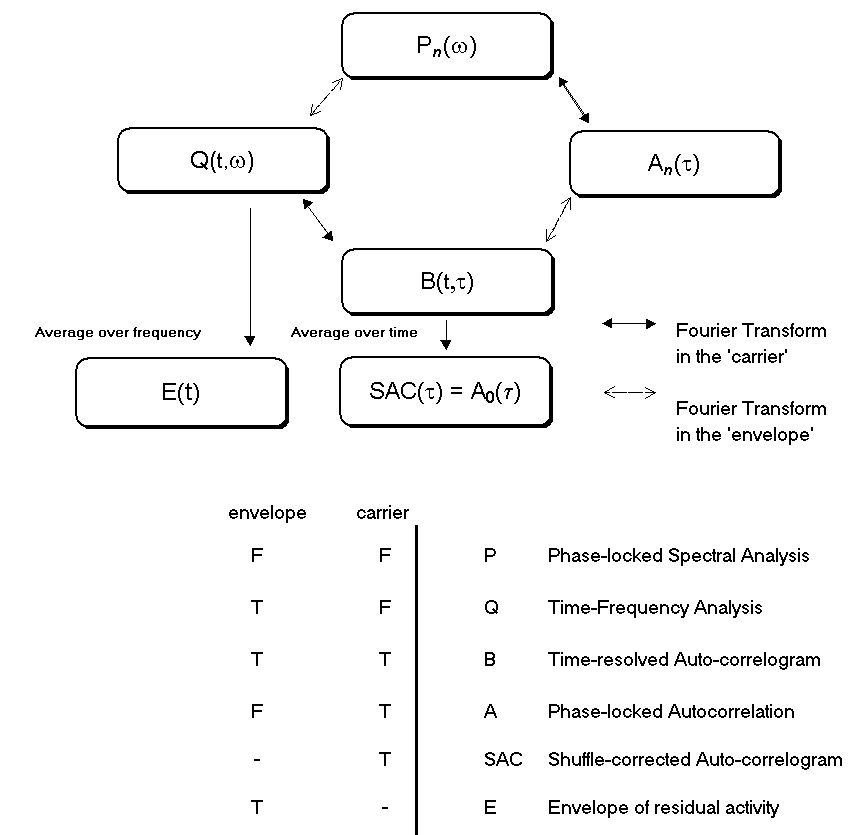
Neuronal activity is often treated as a composition of a stimulus-driven component and a second component which corrupts the signal, adding or deleting spikes at random. Standard quantitative methods such as peri-stimulus histograms and Fourier analysis use stimulus-locked averaging to enhance detection of the driven component of neuronal responses and de-emphasize the 'noise'. However, neural activity also includes bursts, oscillations, and other episodic events which standard averaging methods overlook. If this activity is stimulus-independent, it can be characterized by standard power spectral analysis (or autocorrelation). But activity that is excited by (but not temporally locked to) the visual stimulus cannot be characterized by averaging or standard spectral analysis.
Phase-locked spectral analysis (PLSA) is a new method that examines this 'residual' activity - the difference between the individual responses to each cycle of a periodic stimulus, and their average. With PLSA, residual activity is characterized in terms of temporal envelopes and their carriers. Previously, PLSA demonstrated broadband interactions between periodic visual stimuli and fluctuations in the local field potential of macaque V1 (Victor, et al. 1993). In the present study, single-unit responses (SUA) from parafoveal V1 in anesthetized macaque monkey are examined with this technique.
Recordings were made from 21 neurons, 6 of which were recorded in pairs along with multi-unit activity (MUA) from separate electrodes, and 8 of which were recorded along with MUA from the same electrode. PLSA was applied to responses to preferred (orientation, direction, and spatial frequency) and non-preferred drifting gratings. For preferred stimuli, all cells demonstrated broadband (1-10 Hz and higher) residual activity that waxed and waned with the stimulus cycle, suggesting that changes in the residual activity are routinely introduced by visual stimulation. Moreover, some reconstructed envelopes indicate that the residual activity was sharply gated by the stimulus cycle. Oscillations were occasionally seen in the power spectrum of single units.
Phase-locked cross-spectra were determined for 3 SUA/SUA pairs and 11 SUA/MUA pairs. Residual activity in the cross-spectra was generally much less than the residual activity determined separately from each neuron. The reduction in the residual activity in the cross-spectra suggests that nearby neurons may gate inputs from distinct and relatively independent neuronal subpopulations that together generate the background rhythms of striate cortex.
In the absence of a stimulus, the second-order statistics of neural activity may be characterized in the frequency domain (via the power spectrum) or in the time domain (via the autocorrelation).
In the presence of a stimulus, characterization of second-order statistics requires tracking the relationship of the covariance structure of the spike train and the stimulus.
As illustrated in the diagram below, either the frequency- or the time-domain can be used for the input ("envelope"), and either can be used for the response ("carrier"). Phase-locked spectral analysis, described in more detail in this paper, chooses the frequency-domain approach for both envelope and carrier. As this diagram illustrates, the other three possibilities are related by Fourier transformations. Each are equivalent and complete characterizations of the second-order statistics of a spike train. The shuffle-corrected autocorrelation is an incomplete characterization, since it ignores the statistics of the response that covary with the stimulus.
Each of these approaches can be extended to the characterization of second-order statistics of activity
of pairs of neurons (e.g., phase-locked cross spectrum).
